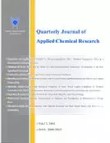فهرست مطالب
Journal of Applied Chemical Research
Volume:15 Issue: 1, Winter 2021
- تاریخ انتشار: 1399/10/13
- تعداد عناوین: 6
-
-
Pages 8-23In the current study, a new technique was developed for quantification and qualification of pseudoephedrine hydrochloride (PSE) in a real sample, which was based on electrochemical sensors and molecular imprinted polymer (MIP). The carbon paste electrode (CPE) was modified and optimized by a different ratio of MIP. MIP/CPE was used as the extraction and working electrode. Differential pulse voltammetry (DPV) method was utilized for measurement. The MIP (molecularly imprinted polymer) and NIP (non-imprinted polymer) were synthesized by various ratios of functional monomer (methacrylic acid) and cross-linker (ethylene glycol dimethacrylate) and template (pseudoephedrine hydrochloride). Some parameters such as pH, extraction time, MIP/CP ratio, stirring rate, and concentration of sample were optimized, and under these conditions, the oxidation peak current was proportional to the pseudoephedrine hydrochloride concentration over a range of 10-500 µM with the coefficient of determination 0.992 (R2). The limit of detection (LOD) was found about 0.274 µM and the limit of quantification (LOQ) was located about 0.825 µM. The relative standard deviation (RSD) was about 1.17%. The results indicated that the modified electrode had a specific ability in selective extraction of pseudoephedrine hydrochloride.Keywords: Molecular Imprinted Polymer, Carbon paste modified electrode, Pseudoephedrine hydrochloride, Voltammetric sensor
-
Pages 24-35
KAl(SO4)2.12H2O is found to efficiently and heterogeneously catalyze the one-pot three-component reaction of 2-(nitromethylene)imidazolidine, malononitrile and aldehydes under mild conditions to afford the corresponding tetrahydroimidazo[1,2-a]pyridine in good yields and short reaction times. Docking study of some compounds in the active site of α-glucosidase demonstrated that these compounds interacted with important active site residues with low binding energy in comparison to standard inhibitor acarbose.
Keywords: Alum, Three-component reactions, Tetrahydroimidazo[1, 2-a]pyridine, Molecular docking studies, α-glucosidase -
Pages 36-45
Potentially harmful disinfection byproducts (DBPs), as a significant challenge in water treatment, are formed when oxidizing disinfectants react with natural organic matters (NOM). Unfortunately, an unwanted side effect is the formation of harmful by-products, such as THMs and HAAs, following the chlorination stage. DBPs cause a variety of diseases like cancer in humans. In this study, the Advanced Oxidation Process (AOP) method was used to reduce HAA contamination in Tehranpars Water Treatment Plant. The EPA Method 552/2 was used for detecting HAA compounds by gas chromatography equipped with an ECD detector. The AOP method was performed in a photoreactor equipped with 4 UV lamps. The effects of UV radiation, the concentration of hydrogen peroxide, level of pH, reaction time, number of UV lamps, and amount of CuO nanocatalyst on the oxidation reaction of HAA were investigated. The results showed that the annual mean levels of DCAA and TCAA in Tehranpars tap water were 0.0526 and 0.232, respectively. The optimum level of CuO nanocatalyst in the AOP process was 0.625 with 99.79% removal of DCAA and 99.22% removal of TCAA. The removal percentage increased with increasing treatment time, hydrogen peroxide level, and the number of the UV lamp at neutral and alkaline pH.
Keywords: advanced oxidation process, CuO, Disinfection by-products, chlorination, Haloaceticacids -
Pages 46-63
For the first time the extract of the plant of Tilia platyphyllos was used to green synthesis of Ag nanoparticles (NPs) supported on Ziziphus jujuba kernel as an environmentally benign support. Ag NPs/ Ziziphus jujuba kernelas an effective catalyst was prepared through reduction of Ag+ions using Tilia platyphyllos extractas the reducing and capping agent and Ag NPs immobilization on Ziziphus jujuba kernel surface in the absence of any stabilizer or surfactant. According to FT-IR analysis, the hydroxyl groups of phenolics in Tilia platyphyllos extract as bioreductant agents are directly responsible for the reduction of Ag+ions and formation of Ag NPs. The as-prepared catalyst was characterized by Fourier transform infrared (FT-IR) and UV-Vis spectroscopy, field emission scanning electron microscopy (FESEM) equipped with an energy dispersive X-ray spectroscopy (EDS), Elemental mapping, X-ray diffraction analysis (XRD) and transmittance electron microscopy (TEM). The synthesized catalyst was used in the reduction of Congo Red (CR), and Methyl Orange (MO) at room temperature.The Ag NPs/Ziziphus jujuba kernel showed excellent catalytic activity in the reduction of these organic dyes. In addition, it was found that Ag NPs/Ziziphus jujuba kernelcan be recovered and reused several times without significant loss of catalytic activity.
Keywords: Ag Nanoparticles, Ziziphus jujuba kernel, Tilia platyphyllos, NaBH4, Organic dyes -
Pages 64-72
In this study, a simple and fast magnetic dispersive solid phase extraction methodology was developed G@Fe3O4/Fe/Ag nanoparticles for preconcentration and determine of phenolic compounds in water samples. The sorbent was characterized by assorted characterization method. The effects of diverse factor on the extraction process were studied thoroughly via design of experiment and desirability function. This work was showed the G@Fe3O4/Fe/Ag NPs was the best sorbent between Graphene, G@Fe3O4/Fe and Fe3O4, 0.01M HNO3in acetonitrile was the most efficiency between eluent types, the best salt content which was 7.5% w/v.
Keywords: response surface methodology, phenolic compounds, Silver Modified, Zero Valent Iron, Fe3O4@G, nanocomposite -
Pages 73-85Ursolic acid (UA) is a major bioactive component in many traditional medicinal plants including pomegranate (Punica granatum L.) flower. In vitro and in vivo studies have both revealed that UA has many important biological functions.In this study, a rapid and efficient procedure for preparation of UA from an Iranian pomegranate flower cultivar using ultrasound-assisted extraction followed by normal-phase flash chromatography (NP-FC) was developed. After one flash chromatography run, the purity of UA reached more than 97% with a total yield of 0.1% of dried pomegranate flower powder. The chemical structure of isolated UA was identified by IR, MS and NMR spectra. This is the first report on isolation of UA from pomegranate flowers. The NP-FC method was shown to be a good method for the purification of UA from pomegranate flowers, and it can be an excellent basis for large-scale preparation of UA from pomegranate flowers or other plant extracts.Keywords: ursolic acid, isolation, Pomegranate flowers, Flash chromatography


